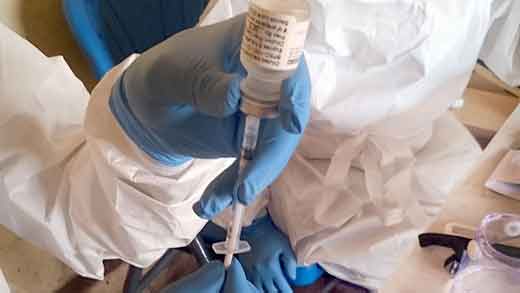Ebola vaccine candidates are currently being evaluated in phase I–III clinical trials conducted in Africa, the EU and the US. Although preclinical development of candidate vaccines utilise different platforms, including inactivated viral particles, DNA vaccines, recombinant viral vectors, recombinant proteins, subunit proteins and virus-like particles, the most advanced vaccine candidates are based on viral vectors engineered to serve as antigen delivery platforms that encode the full length of the surface glycoprotein of the Ebola virus. Examples of viral vectors expressing ebolavirus glycoproteins include recombinant human adenovirus (Ad26), recombinant simian adenovirus (chimpanzee Ad3), recombinant vaccinia virus (MVA) and a live vesicular stomatitis virus (rVSV) used alone or in prime-booster regimens. The genus Ebolavirus, a member of the family of Filoviridae, is comprised of five distinct species: Bundibugyo (BDBV), Ebola virus (EBOV) (formerly designated as Zaire ebolavirus, ZEBOV), Reston (RESTV), Sudan (SUDV) and Taï Forest (TAFV). The EBOV and SUDV species are the predominant causes of most EVD outbreaks. Glycoproteins from the different filoviruses show a high degree of diversity at the nucleotide and amino acid levels (60-65% conservation), implying that vaccines for protection against different filovirus infections would have to express and induce an immune response to several glycoproteins and would optimally be multivalent encoding glycoproteins from different viral species into one vaccine regimen. Single dose or prime-boost regimens are being explored in ongoing clinical trials. To date, at least 15 EVD vaccines are being developed (in North America, Europe, Russia and China), with four main candidates in varying advanced stages of human testing. These include the two most advanced – rVSV-ZEBOV (Merck) and ChAd3-EBO Z (GSK) – as well as a prime-boost regimen of Ad26.ZEBOV and MVA-BN-Filo developed by J&J/Bavarian Nordic, and a recombinant particle made of EBOV glycoprotein produced in an insect cell line, developed by the biotech company Novavax. The two lead vaccine candidates started human clinical trials in September 2014 and data on their safety and immunogenicity profiles were ready by December-January, breaking all records in terms of vaccine trial Phase I timelines. WHO played a key role in this endeavor, by identifying and coordinating numerous trial sponsors to test the vaccines contemporaneously in the US, Canada, and several countries in Europe and Africa. These two vaccines are now in Phase II/III trials in the three affected countries. The trial collaborations underway are: a ring vaccination trial of VSV-EBOV in Guinea, organized through a large international consortium including WHO, MSF, Canada, Norway and universities in the UK, Switzerland and the US; and a cluster based, non-blinded, individually randomized trial of rVSV-ZEBOV in Sierra Leone under a Sierra Leonean-US-CDC collaboration. A Phase II trial of both vaccines was carried out in Liberia under a Liberian government – US-NIH collaboration. This trial was completed at the end of April, and it is not known if trials in Liberia will continue. In the meantime, phase II trials of the GSK vaccine are slated to start in Cameroon, Ghana, Mali, Nigeria and Senegal in the second half of 2015. Pharmaceutical companies developing the vaccines have committed to ramp up production capacity in case of proven vaccine efficacy and the need for deployment. This could be the fastest vaccine roll-out in history. A comprehensive list of the EVD clinical trials can be found on the WHO International Clinical Trials Registry.



